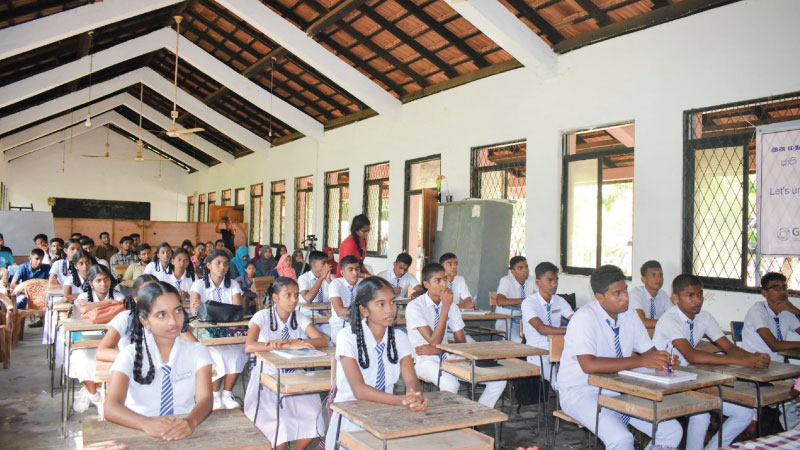This time, the General Certificate of Education Ordinary Level (GCE O/L) examination was held from May 29 to June 8, 2023. It usually takes four months to conduct the exam and the results to be posted. In this process, the answer sheets of the outlying provinces are first brought to the Examination Department in Colombo (Pelawatte) pthrough coordination centres and regional collection centres.
Then they are sent to various centres for re-evaluation. There, the places where answer sheets are sent are kept confidential and the process takes about five days.
 The scoring is done immediately after the exam is over. This process is to mark the control answer sheets. Chief examiners and a group of 10-15 senior teachers are appointed for each subject for these control answer sheet marking boards. This team discusses the procedure of awarding marks for one subject for three or four days.
The scoring is done immediately after the exam is over. This process is to mark the control answer sheets. Chief examiners and a group of 10-15 senior teachers are appointed for each subject for these control answer sheet marking boards. This team discusses the procedure of awarding marks for one subject for three or four days.
Meanwhile, the students’ answer sheets are brought from different areas for the process of marking the controller’s answer sheets. At this time, a study is conducted to find out what answers the candidates have given for each question in every theory paper. A full-time study is conducted over three days on how the students have understood the question and on alternative answers. Finally, the scoring procedure is adopted.
Scoring procedure
The next step is to hold conferences for the Chief Inspectors. The scoring procedure is discussed with them for a second time. Necessary amendments are also made at that time. The scoring procedure is adopted after that. The scoring procedure is then printed for distribution to all the examiners. At this time, the Examination Department takes steps to conduct a simulation exercise with the chief examiners.
This process studies how to give points to the procedure of giving marks. Every possible step is taken to reduce the personal connection that occurs via the examiner, where several photocopies of the same answer sheet are taken and a long discussion on how marks are given is done to reduce the disparities in marking.
This time, 35,000 examiners were needed to monitor the answer sheets for the Ordinary Level examination where seven million answer sheets were evaluated. Although it was a large operation, it prioritised maintaining consistency, fairness and transparency. The answer sheets of those students with special needs were monitored in a separate place.
After marking the answer sheets, another person marks it again. They are randomly checked by the Chief Inspector. Meanwhile, a verification examiner is also appointed to check the accuracy of the math scores.
At the end of the examinations, the mathematics marks are listed and envelopes are sealed and sent to the Examination Department along with the answer sheets. The part where the teachers are involved in the evaluation happens for six weeks. But due to a lack of inspectors, this work had to be done in two stages this time.
Although this evaluation work should have started from the beginning of the O/L examination, due to the teacher and university academic strikes in the past, the A/L evaluation work had to be started on May 20. Because the A/L evaluations had to take place, the O/L evaluations could not be done, so the A-Level evaluations were completed and the O/L evaluations began on August 18.
Short period
Since the regular exam ended on June 8 and the results were given on November 30, many say that it took five months and 22 days for the results to be posted this time round. But those activities officially started on August 18.
Thus, the Examination Department has spent only a short period of three months and 12 days to complete the evaluation of the O/L answer sheets and post results. Such was the mammoth effort of the Examination Department.
The data entry is done once the mark list is received by the Examination Department. For this, seven million answer sheets have to be computerised twice by two people. This is done to enter the most accurate information. If two marks match, then a correction is made and it is a difficult task to computerise 14 million marks.
There are a very limited number of officers for this purpose. Only 250,000 sets of data can be entered in a day. The officers of the Examination Department were able to overcome this challenge by serving day and night continuously.
After entering the data, the Department deducts the deficiencies from the computer section and prepares the results once again with the aim of giving the most accurate result with minimum deficiencies in a way that does not cause injustice to any student.
More inspections
Although the end of the evaluations are 100 percent over, many more inspections are being conducted in the meantime. That is, checking unusual reports; like why did a student who got eight As failed one or why did a student who got one A fail eight subjects? Are the answer sheets of the highest scorers correct? If a student did not appear for the exam, did it really happen?
A report is obtained through each centre. Every test is evaluated to give the most accurate marks to the students. Finally, through the appointment of a grading committee, the grades obtained in connection with the previous examination results are marked.
Even after the grades are given, their correctness is checked again through several teams. After that, the result checking committee and the commissioner in charge of the results will officially request permission to release the results to the head of the Examination Department, the Commissioner General of Examinations, confirming that the examinations are over and all the results are correct. After completing this difficult task, the results were given last 30th midnight with the Commissioner general’s approval.
The Department’s aim in all this work is that no injustice should be done to any student, and give special respect to each student’s answer sheet.
This article is based on an interview with the Commissioner General of Examinations Amitha Jayasundara
Decrease in average pass rate
For the year 2022, 317,657 candidates appeared for the O/L examination, as school and private applicants. The Examination Department states that 236,041 people were eligible to take the A/L examination this year. As a percentage it is 74.31 percent. The Department of Examinations mentions that this year there is a slight decrease in the average pass rate for A/L studies. Compared to last year, it was 73.05 percent in 2017, 75.09 percent in 2018, 73.84 percent in 2019, 76.59 percent in 2020, and 74.52 percent in 2021.
9 As
According to the data of the Examination Department, the number of A 9 passers this year has been high compared to the last few years. This year the number of A 9 passers were at 13,380. In 2021, that amount was 10,863. In terms of percentage, it is 3.13 percent in 2018, 3.34 percent in 2019, 3.78 percent in 2020, 3.49 percent in 2021, and 4.21 percent in 2022.
Failure rate
This year, the number who failed in the O/L examination, i.e. six main subjects and above, has been 7,045 and the percentage is 2.22 percent.
Translated by Jonathan Frank









